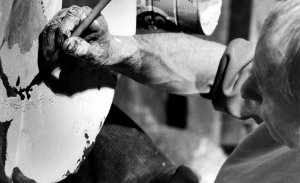Innovator, artist, inventor, teacher. These are only a few words that describe Paul Soldner. In honor of Paul Soldner (1924–2011), emeritus professor of ceramics at Scripps College for more than three decades, the Ruth Chandler Williamson Gallery presents Serendipity: Paul Soldner, Artist and Provocateur. The exhibition, on view from August 27 through December 11, 2011, will illuminate his creative life as an artist and teacher, featuring many works he made at Scripps, where he developed his distinctive approaches to raku and salt-fired ceramics. In addition to vessels, the exhibition will explore other aspects of his work, including wall pieces and monoprints, which demonstrate Soldner’s lesser-known but lively commentary on popular culture. Videos demonstrating different perspectives of Soldner will also be on view. Workshops devoted to Soldner’s special areas of expertise – raku, bonsai, and brush making – will accompany the exhibition. The opening reception, with live music and light refreshments, will take place at the Williamson Gallery on September 10, from 7–9 p.m. The exhibition is free and open to the public.
Much is known of Paul Soldner’s life in working with ceramics. Developed after his return from WWII, Soldner’s philosophy on clay came into its own when he was Peter Voulkos’ first student at the Los Angeles County Art Institute in the mid 1950s. Voulkos, as Dr. Mary MacNaughton, director of the Williamson Gallery, commented, is one of the “artists [who] were catalysts for a definitive shift in the way ceramics were understood,” from craft to art. Voulkos, along with artists John Mason and Ken Price, will be showcased in the exhibition, Clay’s Tectonic Shift: John Mason, Ken Price, and Peter Voulkos, 1956-1968, opening in January as part of the Getty Foundation’s Pacific Standard Time initiative. It was Voulkos who taught Soldner to embrace innovation and experimentation and subsequently influenced Soldner’s teaching style: instruct by example and not by rule.
Soldner’s fascination with refusal to place limitations on clay transformed him into a pioneer, leading him to champion American raku, a low-fire fast-fire process based on Japanese raku. Soldner’s take on raku embodies his life-long ambition to challenge the conventional and break away from established standards. As he said: “In the spirit of raku, there is the necessity to embrace the element of surprise. There can be no fear of losing what was once planned and there must be an urge to grow along with the discovery of the unknown. Make no demands, expect nothing, follow no absolute plan, be secure in change, learn to accept another solution and, finally, prefer to gamble on your own intuition.”
“Serendipity” evokes a sense of the multifaceted Paul Solder. His work in ceramics is world-renowned, yet less is known of Soldner’s interests and work in monoprints, advertising, brush making, and bonsai. The exhibition intends to showcase these interests and provide visitors with different sides of Soldner rarely seen in order to give them a more complete vision of who Paul Soldner was and how his interests and work often came together.
The Ruth Chandler Williamson Gallery is located at Eleventh Street and Columbia Avenue, adjacent to Baxter Hall. During exhibitions, the gallery is open to the public, free of charge, Wednesday through Sunday, from 1 to 5 p.m. For more information, please contact the gallery at (909) 607-3397. (For more information on the raku, bonsai, and brush making workshops, please contact Registrar and Collection Manager Kirk Delman at kdelman@scrippscollege.edu)


